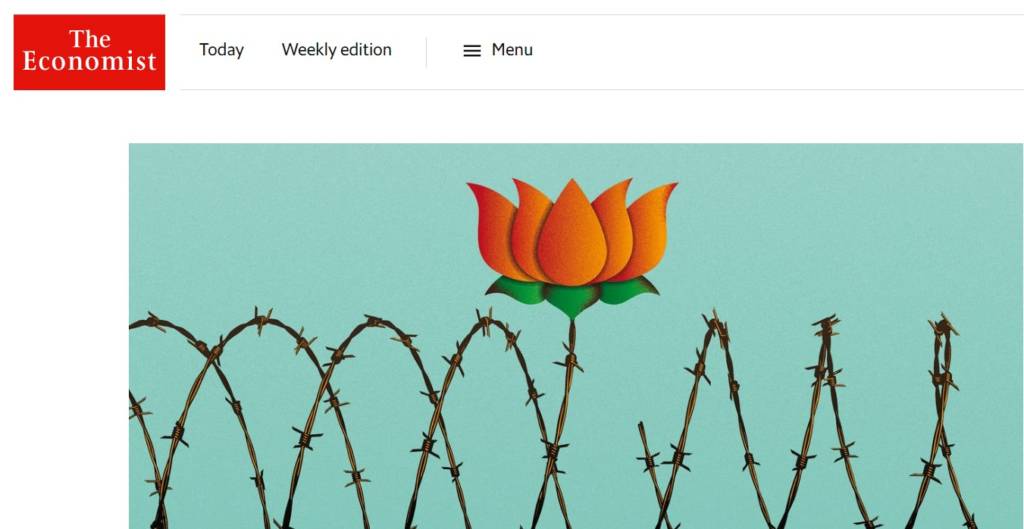The Economist, the weekly British magazine (although it calls the publication newspaper), which claims to be ‘radical centrist’, has constantly criticized Modi government, especially its social and political agenda. The magazine, which ardently supported Globalization in the last few decades, has vehemently criticized the ‘Nationalist’ agenda of PM Modi.
In the last few years, since the rise of Nationalist and protectionist governments across the world, the liberal social and economic agenda of The Economist has been out of sync with the policies of the centre-right governments, whose rise has been unprecedented in the last few years.
Rajdeep Sardesai, the anchor and journalist with India Today Group, shared a tweet with two covers of the magazine, one with the cover of 2010, which was titled ‘How India’s Growth will outpace China’ and the other being the latest cover, which was titled ‘Intolerant India’.
A tale of two covers: 2010 and 2020.. say no more.. or risk being called ‘anti national’! Have a good Friday folks!! pic.twitter.com/rGOw9k1ss8
— Rajdeep Sardesai (@sardesairajdeep) January 24, 2020
In 2010, the year when the inflated growth story of India was coming to an end and the impact of the reforms ushered by Vajpayee government dulled due to the socialist agenda of UPA II, the magazine analyzed that the India economic growth story will overtake that of China.
The UPA II, which The Economist applauded with such heft, has been called the worst government of India by political and policy analysts. The second term of the UPA was mired with corruption, nepotism, public outrage over women security, terrorist attacks, exuberant lending, slowdown of economic growth, and weakening of India’s global stature. But, The Economist praised the Manmohan Singh government as its ideological positions fit into the ‘liberal democracy’ framework of the magazine.
It is important to note that in the last five and a half years of Modi government, India improved on almost every socio-economic indicator. The people coming out of poverty every minute is at an all-time high; infant mortality is all-time low; inflation is at an all-time low; there has hardly been a terror attack in an Indian city; India’s global stature is rising; Indian Prime Minister is extremely popular around the world; and the respect for India is at an all-time high.
The hatred of The Economist for the Modi government is not new. Previously, the mouthpiece of global liberal order has attacked Modi government before the 2019 General Election and voiced support for Congress. The Economist stands for everything that is wrong with current global order like free trade, unchecked globalization, drug liberalization, free immigration, and cultural liberalism.
It supported the presidency of Barack Obama and also voiced its support for Hillary Clinton in 2016 general election. While Barack Obama’s presidency proved disastrous for global security, Clinton lost the election to Donald Trump.
The magazine has been a supporter of Anglo-American global order led by United States. It has repeatedly supported ‘American Exceptionalism’ and justified American intervention on many occasions. It has been subjected to censorship in India because the magazine has shown Pakistan centric map of Kashmir.
Before the 2019 general election, “Under Narendra Modi, India’s ruling party poses a threat to democracy”, wrote the Economist. “Mr Modi has been neither as good for India as his cheerleaders foretold, nor as bad as his critics…imagined. But today the risks still outweigh the rewards,” it added.
It also criticized the Modi government’s decision to carry out Balakot air strikes. “Not so much an act of strength as recklessness that could have ended in disaster”, wrote the magazine. As majority of Indians including Congress party supported the air strikes, it is very clear that the views of liberal mouthpiece do not match to the majority of Indian population and political parties. The Economist is not different from other liberal mouthpiece like New York Times and Reuters which still hold orientalist view of India.
The Economist is also opposed to the Modi government’s strong action against Kashmiri separatists. Interestingly, the magazine criticized Modi government for quelling press freedom. As per magazine, Modi government “cowed the press”, “suborned respected government institutions… as well as loosing tax collectors on political opponents… and cocking a snook at rules meant to insulate the army from politics.”
Foreign media’s obsession with India is not new. They always portray India in a negative light and leave no stone unturned to malign India’s image with their lies and propaganda at a global level. The foreign media’s incipient hatred for India is very well known. Despite the fact that India has made significant progress since its independence, the foreign media still presents India as a backward land of snake charmers and many other derogatory tags have been given to India. It shows the racist mentality of the foreign media.
